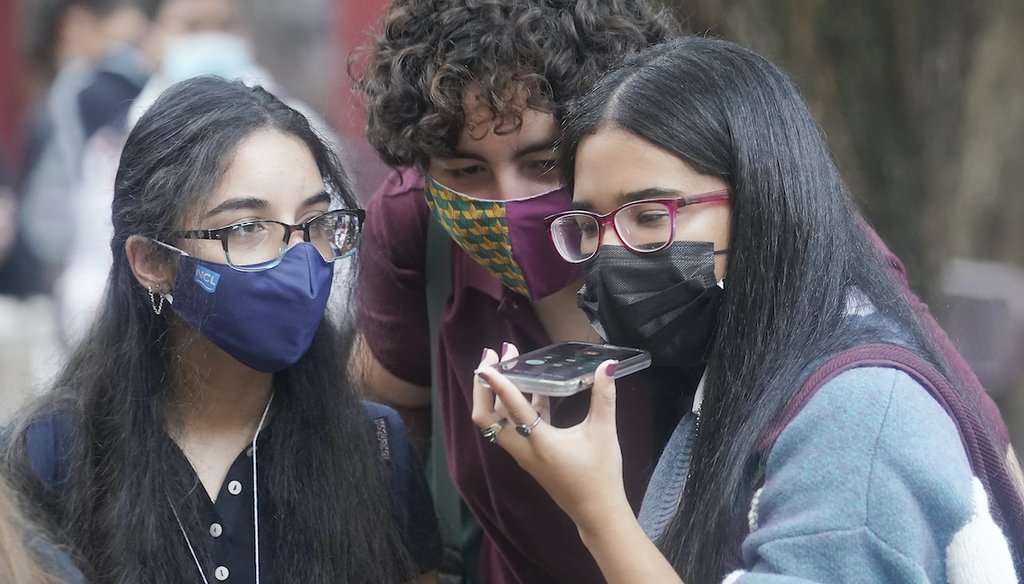



Students try to connect with their friends during the first day of school at Barbara Coleman Senior High School, Monday, Aug. 23, 2021, in Miami Lakes, Fla. (AP)
A Facebook post alluding to COVID-19 carried this admonishment:
"WARNING UNMASK YOUR KIDS! Any Carbon Dioxide concentrations above 2000ppm is dangerous!"
The post was flagged as part of Facebook’s efforts to combat false news and misinformation on its News Feed. (Read more about our partnership with Facebook.)
There is no evidence that masks endanger children by trapping carbon dioxide.
As evidence for its claim, the Facebook post shares a minute-long TikTok video that purports to show a handheld device measuring carbon dioxide levels inside a paper medical mask being worn by a young girl.
At one point, the readings exceeded 7,100, according to a woman in the video, who adds: "Remember, anything above 2,000 is unacceptable."
It’s not clear in this claim what 2,000 parts per million refers to, but this is the latest in a series of claims made with demonstrations that don’t actually show what they claim to show.
Here’s what we know based in part from our latest check, on a claim that a similar demonstration with an oxygen sensor shows that cloth masks are dangerous for children, which we rated False:
The air we breathe is made up of about 78% nitrogen by volume, 21% oxygen and much smaller amounts of argon, carbon dioxide, hydrogen and other gases.
Kirsten Koehler, an environmental health and engineering professor at the Johns Hopkins University Bloomberg School of Public Health, said the kind of sensor seen in this video is not suited to do what the demonstrator suggests its measuring.
"As with the concentration of O2, the concentration of CO2 in the air in the mask will be changing dramatically, very rapidly with each breath," Koehler said. "These types of sensors are not able to respond to these changes."
The result is that what the sensor measures is not accurate for either inhaled or exhaled air.
"If masks were really dangerous, you would expect to see changes in the oxygen saturation of blood," she said. "However, as numerous videos online and several peer-reviewed publications show, oxygen saturation in blood does not change when wearing a mask, even when exercising."
Biology professor Benjamin Neuman, chief virologist at Texas A&M University’s Global Health Research Complex, said such tests — holding a device just inside a child’s mask — do not tell the difference between exhaled air, which is high in carbon dioxide, from inhaled air, which is low in carbon dioxide, because the monitor is under the mask where the child is both inhaling and exhaling. Holding a meter up to exhaled air would give the result shown. But the mask is porous, and most of the air for each new breath comes in through the mask."
A more accurate way to assess the effect of a mask on oxygen flow is to analyze a blood sample, Neuman said. Or, "a reasonable do-it-yourself test would be to wear a pulse oximeter while wearing a mask or not wearing a mask for longer periods of time, perhaps half an hour each, and then compare oxygen saturation levels." The test would have to be repeated several times to get an accurate reading.
"Fortunately, this work has already been done quite carefully in several papers, which demonstrated no significant drop in oxygen content or rise in carbon dioxide content when wearing a mask," Neuman said.
PolitiFact reporting has found that science shows mask-wearing is largely safe for children.
Scientists have found little evidence that the kind of masks worn by students negatively affect oxygen or carbon dioxide levels, and they say that contamination levels on masks are no worse than on other common objects.
The prolonged use of medical masks when properly worn, does not cause CO2 intoxication nor oxygen deficiency, according to the World Health Organization.
The federal Centers for Disease Control and Prevention says: "Wearing a mask does not raise the carbon dioxide (CO2) level in the air you breathe. Cloth masks and surgical masks do not provide an airtight fit across the face. The CO2 escapes into the air through the mask when you breathe out or talk. CO2 molecules are small enough to easily pass through mask material. In contrast, the respiratory droplets that carry the virus that causes COVID-19 are much larger than CO2, so they cannot pass as easily through a properly designed and properly worn mask."
Babak Javid, a professor of medicine at the University of California-San Francisco, told PolitiFact that the issue "has been convincingly debunked."
A Facebook post claimed: "Unmask your kids! Any carbon dioxide concentrations above" 2,000 parts per million are "dangerous!"
There is no evidence that children’s health is endangered by a buildup of carbon dioxide caused by masks.
We rate the post False.
Facebook, post, Oct. 26, 2021
Email, Kirsten Koehler, an environmental health and engineering professor at the Johns Hopkins University Bloomberg School of Public Health, Nov. 1, 2021
PolitiFact, "Another air quality monitor demonstration fails to show masks reduce oxygen," Sept. 8, 2021
PolitiFact, "Science shows mask-wearing is largely safe for children," Aug. 12, 2021
USA Today, "Fact check: Face masks are safe for children, help prevent COVID-19 spread," Oct. 29, 2021
World Health Organization, "Coronavirus disease (COVID-19) advice for the public: Mythbusters," May 5, 2021
Centers for Disease Control and Prevention, "Your Guide to Masks," Oct. 25, 2021
In a world of wild talk and fake news, help us stand up for the facts.
